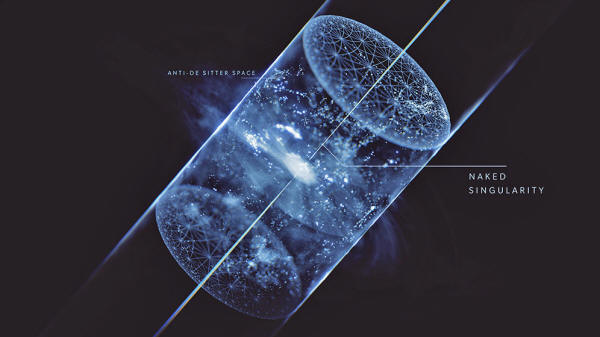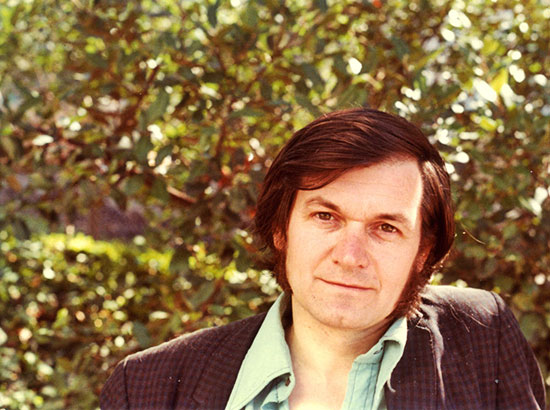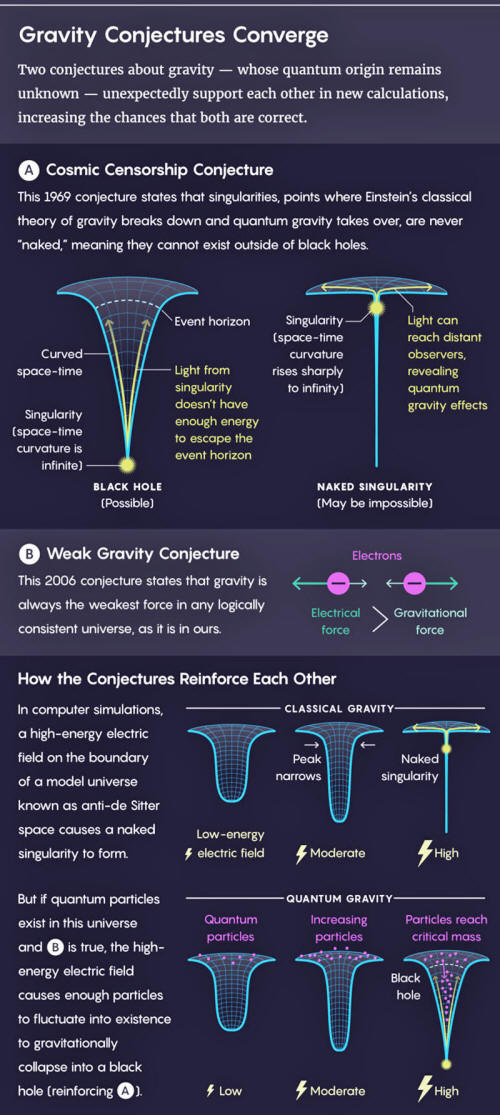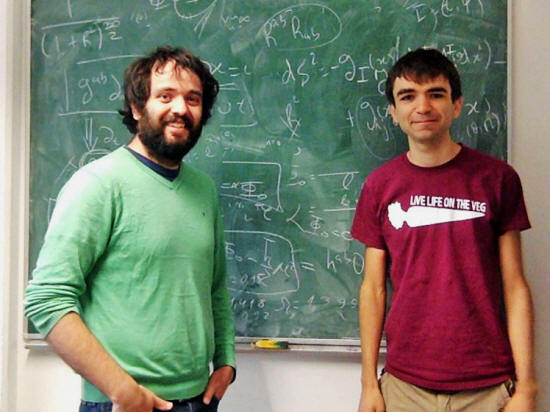|
by Natalie Wolchover from QuantaMagazine Website
for Quanta Magazine two conjectures about gravity, potentially revealing new truths about its elusive quantum nature.
Singularities - snags in the otherwise smooth fabric of space and time where Albert Einstein's classical gravity theory breaks down and the unknown quantum theory of gravity is needed - seem to always come cloaked in darkness, hiding from view behind the event horizons of black holes.
The British physicist and mathematician Sir Roger Penrose conjectured in 1969 that visible or "naked" singularities are actually forbidden from forming in nature, in a kind of cosmic censorship.
But why should quantum
gravity censor itself?
Some experts say the mutually supportive relationship between the two conjectures increases the chances that both are correct.
And while this would mean singularities do stay frustratingly hidden, it would also reveal an important feature of the quantum gravity theory that eludes us.
The new work (Violating the Weak Cosmic Censorship Conjecture in Four-Dimensional Anti-de Sitter Space), reported in May in Physical Review Letters by Jorge Santos and his student Toby Crisford at the University of Cambridge and relying on a key insight by Cumrun Vafa of Harvard University, unexpectedly ties cosmic censorship to the 2006 weak gravity conjecture, which asserts that gravity must always be the weakest force in any viable universe, as it is in ours.
(Gravity is by far the weakest of the four fundamental forces; two electrons electrically repel each other 1 million trillion trillion trillion times more strongly than they gravitationally attract each other.)
Santos and Crisford were able to simulate the formation of a naked singularity in a four-dimensional universe with a different space-time geometry than ours.
But they found that if another force exists in that universe that affects particles more strongly than gravity, the singularity becomes cloaked in a Black Hole.
In other words, where a perverse pinprick would otherwise form in the space-time fabric, naked for all the world to see, the relative weakness of gravity prevents it.
Roger Penrose in Berkeley, California, in 1978,
nine years after proposing the cosmic censorship conjecture. Source: Archives of the Mathematisches Forschungsinstitut Oberwolfach
Santos and Crisford are running simulations now to test whether cosmic censorship is saved at exactly the limit where gravity becomes the weakest force in the model universe, as initial calculations suggest.
Such an alliance with the better-established cosmic censorship conjecture would reflect very well on the weak gravity conjecture.
And if weak gravity is right, it points to a deep relationship between gravity and the other quantum forces, potentially lending support to string theory over a rival theory called loop quantum gravity.
The "unification" of the forces happens naturally in string theory, where gravity is one vibrational mode of strings and forces like electromagnetism are other modes.
But unification is less obvious in loop quantum gravity, where space-time is quantized in tiny volumetric packets that bear no direct connection to the other particles and forces.
The new work,
The Naked Singularities
In 1991, Preskill and Kip Thorne, both theoretical physicists at Caltech, visited Stephen Hawking at Cambridge.
Hawking had spent decades exploring the possibilities packed into the Einstein equation, which defines how space-time bends in the presence of matter, giving rise to gravity.
Like Penrose and everyone else, he had yet to find a mechanism by which a naked singularity could form in a universe like ours.
Always, singularities lay at the centers of black holes - sinkholes in space-time that are so steep that no light can climb out. He told his visitors that he believed in cosmic censorship.
Preskill and Thorne, both experts in quantum gravity and black holes (Thorne was one of three physicists who founded the black-hole-detecting LIGO experiment), said they felt it might be possible to detect naked singularities and quantum gravity effects.
The bet had to be settled on a technicality and renegotiated in 1997, after the first ambiguous exception cropped up.
Matt Choptuik, a physicist at the University of British Columbia who uses numerical simulations to study Einstein's theory, showed that a naked singularity can form in a four-dimensional universe like ours when you perfectly fine-tune its initial conditions.
Nudge the initial data by any amount, and you lose it - a black hole forms around the singularity, censoring the scene.
This exceptional case doesn't disprove cosmic censorship as Penrose meant it, because it doesn't suggest naked singularities might actually form.
Nonetheless, Hawking conceded the original bet and paid his debt per the stipulations,
He embarrassed Preskill by making him wear a T-shirt featuring a nearly-naked lady while giving a talk to 1,000 people at Caltech.
The clothing was supposed to be,
The physicists posted a new bet online, with language to clarify that only non-exceptional counterexamples to cosmic censorship would count.
And this time, they agreed,
The wager still stands 20 years later, but not without coming under threat.
In 2010, the physicists Frans Pretorius and Luis Lehner, discovered a mechanism (Black Strings, Low Viscosity Fluids, and Violation of Cosmic Censorship) for producing naked singularities in hypothetical universes with five or more dimensions.
And in their May paper, Santos and Crisford reported a naked singularity in a classical universe with four space-time dimensions, like our own, but with a radically different geometry.
This latest one is,
Preskill agrees that it doesn't settle the bet.
But it does change the story...
The Tin Can Universe
Lucy Reading-Ikkanda Quanta Magazine
The new discovery began to unfold in 2014, when Gary Horowitz, Santos and Benson Way found that naked singularities could exist in a pretend 4-D universe called "anti-de Sitter" (AdS) space whose space-time geometry is shaped like a tin can.
This universe has a boundary - the can's side - which makes it a convenient testing ground for ideas about quantum gravity:
In universes like our own, which is closer to a "de Sitter" (dS) geometry, the only boundary is the infinite future, essentially the end of time.
Timeless infinity doesn't make a very good surface for projecting a hologram of a living, breathing universe.
Despite their differences, the interiors of both AdS and dS universes obey Einstein's classical gravity theory - everywhere outside singularities, that is. If cosmic censorship holds in one of the two arenas, some experts say you might expect it to hold up in both.
Horowitz, Santos and Way were studying what happens when an electric field and a gravitational field coexist in an AdS universe.
Their calculations suggested that cranking up the energy of the electric field on the surface of the tin can universe will cause space-time to curve more and more sharply around a corresponding point inside, eventually forming a naked singularity.
In their recent paper, Santos and Crisford verified the earlier calculations with numerical simulations.
But why would naked singularities exist in 5-D and in 4-D when you change the geometry, but never in a flat 4-D universe like ours?
Weak Gravity to the Rescue
In 2015, Horowitz mentioned the evidence for a naked singularity in 4-D AdS space to Cumrun Vafa, a Harvard string theorist and quantum gravity theorist who stopped by Horowitz's office.
Vafa had been working to rule out large swaths of the 10500 different possible universes that string theory naively allows.
He did this by identifying "swamplands":
By understanding patterns of land and swamp, he hoped to get an overall picture of quantum gravity.
Working with Arkani-Hamed, Lubo Motl and Alberto Nicolis in 2006, Vafa proposed the weak gravity conjecture as a swamplands test.
The researchers found that universes only seemed to make sense when particles were affected by gravity less than they were by at least one other force.
Dial down the other forces of nature too much, and violations of causality and other problems arise.
The weak-gravity requirement drowns huge regions of the quantum gravity landscape in swamplands.
Jorge Santos (left) and Toby Crisford of the University of Cambridge
have found an
unexpected link between two conjectures about gravity.
Weak gravity and cosmic censorship seem to describe different things, but in chatting with Horowitz that day in 2015, Vafa realized that they might be linked.
Horowitz had explained Santos and Crisford's simulated naked singularity:
But Vafa reasoned that, if such particles existed, and if, in accordance with the weak gravity conjecture, they were more strongly coupled to the electric field than to gravity, then cranking up the electric field on the AdS boundary would cause sufficient numbers of particles to arise in the corresponding region in the interior to gravitationally collapse the region into a black hole, preventing the naked singularity.
Subsequent calculations by Santos and Crisford supported Vafa's hunch.
The simulations they're running now could verify that naked singularities become cloaked in black holes right at the point where gravity becomes the weakest force.
Quantum Gravity
The full implications of the new work, and of the two conjectures, will take time to sink in.
Cosmic censorship imposes an odd disconnect between quantum gravity at the centers of black holes and classical gravity throughout the rest of the universe.
Weak gravity appears to bridge the gap, linking quantum gravity to the other quantum forces that govern particles in the universe, and possibly favoring a stringy approach over a loopy one.
Preskill said,
However, Lee Smolin of the Perimeter Institute, one of the developers of loop quantum gravity, has pushed back, arguing that if weak gravity is true, there might be a loopy reason for it.
And he contends that there is a path to unification of the forces within his theory - a path that would need to be pursued all the more vigorously if the weak gravity conjecture holds.
Given the apparent absence of naked singularities in our universe, physicists will take hints about quantum gravity wherever they can find them.
They're as lost now in the endless landscape of possible quantum gravity theories as they were in the 1990s, with no prospects for determining through experiments which underlying theory describes our world.
Weak gravity might be one such property - a necessary condition for quantum gravity's consistency that spills out and affects the world beyond black holes.
These may be some of the only clues available to help researchers feel their way into the darkness.
|





